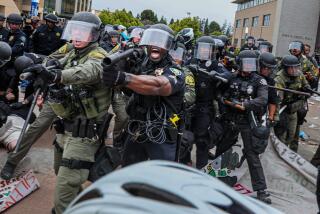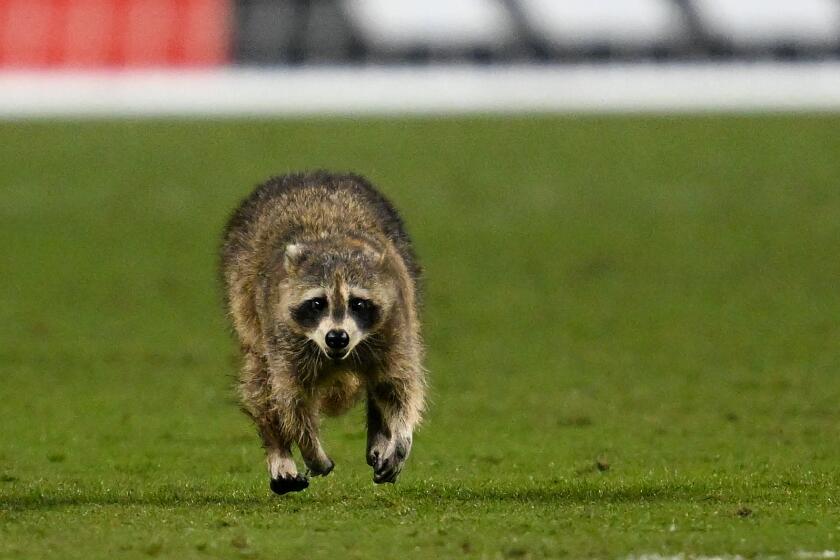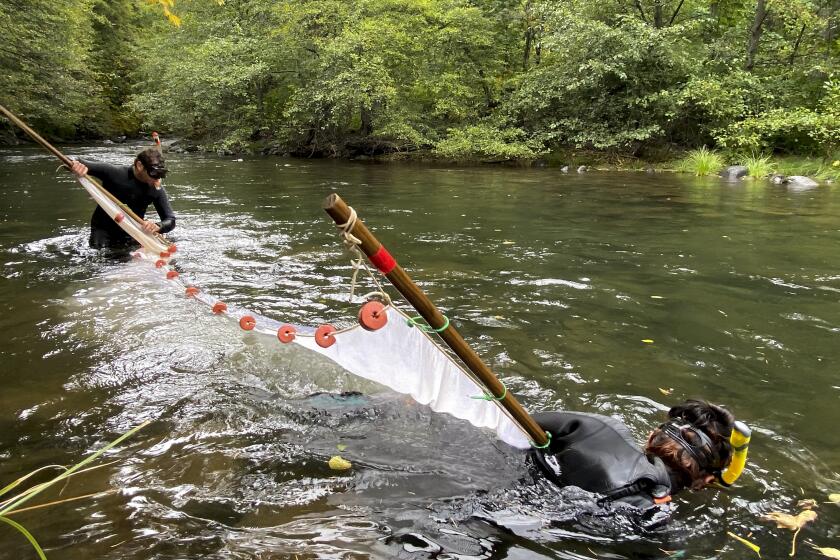Bear Encounters, Attacks Grow
Black bears are increasingly displaying a bit of ursine bravado as human expansion encroaches upon their habitat and drought conditions across much of California play havoc with their natural food supply, a point illustrated by the July 29 attack on a La Verne woman.
The black bear population has doubled statewide in the last 20 years to an estimated 23,000. The bear’s proliferation in Southern California has caused state Fish and Game officials to redraw the map of the black bear’s range to extend 100 miles farther south from Riverside County, almost to the Mexico border.
“The bears are just doing what’s natural as far as expanding onto decent bear habitat and making a living,” said Doug Updike, a senior wildlife biologist for the state Department of Fish and Game.
Although statistics on bear-human encounters are not compiled by Fish and Game authorities, experts say anecdotal evidence indicates that they are on the rise.
Last year, Fish and Game officials issued almost 250 special permits that led to the killing of about 125 “problem” bears, a slight increase from the previous year, Updike said.
The growth in the state’s bear population is creating intense competition among the animals for already scarce food supplies.
As berries and succulent herbs grow scarce, bears can become junk food junkies by raiding trash cans, garages, cars and coolers for food.
“They can rip the door off any car in 15 seconds if there’s a bag of Chee-tos in there,” said Scott Gediman, Yosemite National Park spokesman. “That’s a high-calorie meal for them and a very small amount of effort for a big reward. Once they become habituated to [human] food and continue to seek it out, they sometimes become unnaturally aggressive.”
In the July 29 attack, Barbara Morales was sitting at a table during a midday lunch break at the Marshall Canyon Tree Farm near La Verne when a young bear bit her on the arm. The bear had been seen foraging through trash cans at the complex over the previous six weeks. It had tried to break into a car in its search for food. The animal was shot and killed by Los Angeles County sheriff’s deputies after it bit Morales.
“It was not scared of me in any way or shape,” she said. “I keep thinking, what if it got my throat or my face, or it got one of my arteries?”
Bitten Woman Hasn’t Returned to Work
Morales, treated for puncture wounds, has not yet returned to her job as an emergency medical technician in Orange County.
“I can’t even bend my fingers,” she said. “Getting dressed is hard.”
The attack was the latest in a recent string of bear-human encounters.
Sherman Lambert, a Pacific Palisades naturalist, has seen dozens of black bears over decades of traveling California trails and never had a problem. Until last month.
As he hiked Kings Canyon National Park near Fresno a few weeks ago, Lambert encountered a 250-pound male black bear on the trail. He picked up a 2-foot-long stick and waved it at the bear, attempting to scare it off. When that didn’t work, he snapped the stick in half, hoping to startle the animal. But the bear stood its ground, studying Lambert without fear.
Lambert then scooped up a grapefruit-size rock to protect himself and began shouting. The animal finally retreated, slowly.
“I felt like it was challenging me,” Lambert said. “I never thought the black bear was dangerous until then.”
Lambert ran into similarly unfazed black bears three weeks ago at San Gorgonio Park near Redlands. He was on his way to fetch water from a stream when he encountered a female bear with two cubs. He began shouting and the bears retreated.
When Lambert returned to his campsite, a supposedly bear-proof sack filled with food was missing. And the post he had tied it to had been yanked from the ground.
“To be honest, I’m now more hesitant to camp if I’m the only one for several miles around,” Lambert said. “For 20 years I’ve encountered [black bears], but the sense of danger is something new. They’ve lost a fear of humans.”
Mark Fattal would agree that the bears have shed their image as relatively timid.
Fattal, who spends weekends at a cabin in Chantry Flat, a hiking trail head five miles north of Arcadia in the Angeles National Forest, recently killed a three-foot rattlesnake and had placed it out in the sun, hoping to dry the skin and give it to his son.
That evening, after Fattal had returned to his Lancaster home, a black bear apparently caught scent of the dead snake and made a meal of it.
When Fattal returned the next day, the snake was gone and a wooden outhouse 30 feet uphill from the cabin bore bear claw marks.
Bear encounters are not all that surprising, experts say.
“The animals in the [Angeles] National Forest are all wild,” said forest spokeswoman Randi Jorgensen. “They bite, they kick, they don’t understand [human scents]. They look cute and cuddly, but you’re doing the animal a favor if you don’t approach it.”
Black bears, whose sense of smell is 100 times more keen than that of humans, are growing bolder, Updike said.
Two attacks by brazen bears in Colorado recently forced the closing of a Boy Scout camp near Poncha Springs, 70 miles southwest of Colorado Springs.
On Thursday, a 17-year-old boy awoke on his cot to find himself eye-to-eye with a black bear that had clawed through his tent. The bear bit Paul Marusak, an Eagle Scout from Shawnee, Kan., on the back before he and another Scout chased it away by screaming and throwing shoes at it. Efforts to track that bear failed.
On July 24, Scout leader Vicki Mynhier was dragged from the same tent by a bear that bit her hand. Authorities later cornered and killed the animal they believed attacked Mynhier.
A bear specialist for the U.S. Fish and Wildlife service said the attacks were highly unusual: “It’s not something that’s ongoing everywhere,” said Chris Servineen. “Next year, there could be none.”
With its old rival, the much larger and more aggressive grizzly bear, having disappeared from California more than 75 years ago, black bears now have the territory pretty much all to themselves.
Bear sightings are more common in Central and Northern California, and encounters between bears and people also have risen in those areas.
More Encounters Inside City Limits
A black bear that wandered into downtown Carmel, a resort town 70 miles south of San Jose, was chased up a tree by Fish and Game wardens.
It was shot with a tranquilizer dart, but it continued to climb higher in the tree before falling to its death.
“It was real surprising for an area that doesn’t generally see a lot of bears,” said Steve Martarano, a Fish and Game spokesman. “It drew a big crowd and it was right in the middle of the day. It was a circus-like atmosphere. And then, when things didn’t turn out the way we wanted, we took a lot of criticism for not waiting it out.”
Ten days later, police chased a black bear through backyards in Salinas, 25 miles northeast of Carmel. The bear scaled a 10-foot security fence and crashed through a glass door at an equipment rental store. After taking refuge behind plasterboard propped against a wall, it was shot with a tranquilizer dart by Fish and Game wardens, who later released the animal in the Los Padres National Forest.
“That one ended peacefully,” Martarano said.
In June, a bear was found dead on a roadside just five miles south of San Francisco, apparently struck and killed by a vehicle. It was the first black bear seen within 50 miles of San Francisco in nearly 40 years. The carcass was gone by the time Fish and Game officials arrived, possibly picked up illegally by a passing motorist.
That a bear found its way to the urban fringe was a stunner.
“It’s a really unusual circumstance,” Updike said. “From what I can gather, the bear was there because it was making a living on garbage. That’s really the problem. It’s people’s bad habit of attracting bears that is really causing the problem.”
Yosemite’s Gediman said the park has tried to educate visitors on proper behavior and food storage in bear country. The effort has resulted in a marked decrease in damage to cars and other property.
In 1998, bears broke into 1,100 vehicles and caused $630,000 in damage at the park. Last year, the animals broke into 215 vehicles and caused $126,000 in damage.
The problem needs to be addressed statewide, Gediman said.
“There’s really nowhere else for [black bears] to go as we continue to build more out into rural areas, putting up homes and developing shopping centers in their habitat,” Gediman said.
Bear-human encounters are going to continue, he said, “ so what we need to do . . . is ensure that people are storing their food properly. Or else somebody’s really going to get hurt.”
(BEGIN TEXT OF INFOBOX / INFOGRAPHIC)
The Bear Facts
Despite their name, black bears range in color from black to cinnamon, sometimes with white chest markings. The average bear weighs about 200 pounds and stands 3 1/2 feet tall on all fours.
Some males weigh more than 500 pounds.
IF YOU SEE A BLACK BEAR
Give the bear plenty of room to pass.
Don’t run. Stand up, raise your arms and open your jacket. Yell at the bear and create a commotion by banging pots and pans or other objects.
If bear attacks, fight back. Throw rocks or strike bear with branches or camping equipment.
Make noise while hiking to avoid surprising a bear.
Don’t approach or pick up a bear cub, which may cause the mother to attack.
FORAGING
One meal from a house, car or campsite is all it takes for a bear to associate people with food and become aggressive.
As winter approaches, bears will forage up to 20 hours a day, and store enough fat to sustain them through hibernation. When spring arrives, bears emerge from their dens hungry. They travel miles for food.
Black bears eat meat and vegetation. A typical diet consists of nuts, berries, plants, roots, fruit, honey, insects and larvae as well as fish, small mammals and carrion.
ESTIMATED BLACK BEAR POPULATION IN CALIFORNIA
1982: 9,000
2000: 23,000
Source: California Dept. of Fish and Game
More to Read
Start your day right
Sign up for Essential California for news, features and recommendations from the L.A. Times and beyond in your inbox six days a week.
You may occasionally receive promotional content from the Los Angeles Times.







